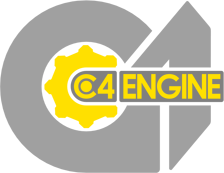Related Research Articles

Global illumination (GI), or indirect illumination, is a group of algorithms used in 3D computer graphics that are meant to add more realistic lighting to 3D scenes. Such algorithms take into account not only the light that comes directly from a light source, but also subsequent cases in which light rays from the same source are reflected by other surfaces in the scene, whether reflective or not.

In 3D computer graphics, a voxel represents a value on a regular grid in three-dimensional space. As with pixels in a 2D bitmap, voxels themselves do not typically have their position explicitly encoded with their values. Instead, rendering systems infer the position of a voxel based upon its position relative to other voxels.

Ray casting is the methodological basis for 3D CAD/CAM solid modeling and image rendering. It is essentially the same as ray tracing for computer graphics where virtual light rays are "cast" or "traced" on their path from the focal point of a camera through each pixel in the camera sensor to determine what is visible along the ray in the 3D scene. The term "Ray Casting" was introduced by Scott Roth while at the General Motors Research Labs from 1978–1980. His paper, "Ray Casting for Modeling Solids", describes modeled solid objects by combining primitive solids, such as blocks and cylinders, using the set operators union (+), intersection (&), and difference (-). The general idea of using these binary operators for solid modeling is largely due to Voelcker and Requicha's geometric modelling group at the University of Rochester. See solid modeling for a broad overview of solid modeling methods. This figure on the right shows a U-Joint modeled from cylinders and blocks in a binary tree using Roth's ray casting system in 1979.

The Build Engine is a first-person shooter engine created by Ken Silverman, author of Ken's Labyrinth, for 3D Realms. Like the Doom engine, the Build Engine represents its world on a two-dimensional grid using closed 2D shapes called sectors, and uses simple flat objects called sprites to populate the world geometry with objects.
Houdini is a 3D animation software application developed by Toronto-based SideFX, who adapted it from the PRISMS suite of procedural generation software tools.

Comanche is a series of simulation games published by NovaLogic, later THQ Nordic after their acquisition. The goal of each of these games is to fly military missions in a RAH-66 Comanche attack helicopter, which was in development and prototyping at the time of release.
A first-person shooter engine is a video game engine specialized for simulating 3D environments for use in a first-person shooter video game. First-person refers to the view where the players see the world from the eyes of their characters. Shooter refers to games which revolve primarily around wielding firearms and killing other entities in the game world, either non-player characters or other players.
In computer graphics, per-pixel lighting refers to any technique for lighting an image or scene that calculates illumination for each pixel on a rendered image. This is in contrast to other popular methods of lighting such as vertex lighting, which calculates illumination at each vertex of a 3D model and then interpolates the resulting values over the model's faces to calculate the final per-pixel color values.

The C4 Engine is a proprietary computer game engine developed by Terathon Software that is used to create 3D games and other types of interactive virtual simulations for PlayStation 5, PlayStation 4, PlayStation 3, Windows, Mac OS X, Linux, and iOS.

In the field of 3D computer graphics, deferred shading is a screen-space shading technique that is performed on a second rendering pass, after the vertex and pixel shaders are rendered. It was first suggested by Michael Deering in 1988.
MT Framework is a game engine created by Capcom. "MT" stands for "Multi-Thread", "Meta Tools" and "Multi-Target". While initially MT Framework was intended to power 2006's Dead Rising and Lost Planet: Extreme Condition only, Capcom later decided for their internal development divisions to adopt it as their default engine. As a result, the vast majority of their internally developed video games for the PlayStation 3 and Xbox 360 platforms were created on it, including four new titles and three remastered ports of past titles in the Resident Evil series. The visuals of the first games built with the engine were well received, and MT Framework has also won a CEDEC award.

Computer graphics deals with generating images and art with the aid of computers. Today, computer graphics is a core technology in digital photography, film, video games, digital art, cell phone and computer displays, and many specialized applications. A great deal of specialized hardware and software has been developed, with the displays of most devices being driven by computer graphics hardware. It is a vast and recently developed area of computer science. The phrase was coined in 1960 by computer graphics researchers Verne Hudson and William Fetter of Boeing. It is often abbreviated as CG, or typically in the context of film as computer generated imagery (CGI). The non-artistic aspects of computer graphics are the subject of computer science research.

Euclideon Pty Ltd is an Australian computer software company known for a middleware 3D graphics engine, called Unlimited Detail. Euclideon is also the parent company and operator of Holoverse, a 'holographic entertainment centre' located on the Gold Coast, in Queensland, Australia. Euclideon claims that Unlimited Detail is based on a point cloud search engine indexing system and that the technology can provide 'unlimited graphics power', proposing it as a replacement for polygon-based rendering.
Silicon Studio is a Japanese computer graphics technology company and video game developer based in Tokyo. As a technology company, Silicon Studio has produced several products in the 3D computer graphics field, including middleware software, such as a post-processing visual effects library called YEBIS, as well as general real-time graphics engines and game development engines, such as OROCHI and Mizuchi, a physically based rendering engine. As a video game developer, Silicon Studio has worked on different titles for several gaming platforms, most notably, the action-adventure game 3D Dot Game Heroes on the PlayStation 3, the two role-playing video games Bravely Default and Bravely Second: End Layer on the Nintendo 3DS, and Fantasica on the iOS and Android mobile platforms.
Deep Down is an action role-playing video game developed and published by Capcom. It was announced for PlayStation 4 in 2013, but entered development hell and, despite being near completion, was not released. It is vaporware, although not officially cancelled. A science fantasy game with cooperative multiplayer elements, it takes place in far-future New York City, and players are teleported back in time by touching magical artifacts.
Luminous Engine, originally called Luminous Studio, is a multi-platform game engine developed and used internally by Square Enix and later on by Luminous Productions. The engine was developed for and targeted at eighth-generation hardware and DirectX 11-compatible platforms, such as Xbox One, the PlayStation 4, and versions of Microsoft Windows. It was conceived during the development of Final Fantasy XIII-2 to be compatible with next generation consoles that their existing platform, Crystal Tools, could not handle.

Resident Evil 7: Biohazard is a 2017 survival horror game developed and published by Capcom. The player controls Ethan Winters as he searches for his long-missing wife in a derelict plantation occupied by an infected family, solving puzzles and fighting enemies. Resident Evil 7 diverges from the more action-oriented Resident Evil 5 and Resident Evil 6, returning to the franchise's survival horror roots, emphasizing exploration. It is the first main Resident Evil game to use a first-person view.
This is a glossary of terms relating to computer graphics.

Physically based rendering (PBR) is a computer graphics approach that seeks to render images in a way that models the lights and surfaces with optics in the real world. It is often referred to as "Physically Based Lighting" or "Physically Based Shading". Many PBR pipelines aim to achieve photorealism. Feasible and quick approximations of the bidirectional reflectance distribution function and rendering equation are of mathematical importance in this field. Photogrammetry may be used to help discover and encode accurate optical properties of materials. PBR principles may be implemented in real-time applications using Shaders or offline applications using Ray tracing (graphics) or Path tracing.
References
- 1 2 Ijuin 2014, p. 1.
- 1 2 3 Ijuin 2014, p. 2.
- ↑ Panta Rhei engine, Pt.1(game.watch.impress.co.jp) p.1. (japanese)
- ↑ Panta Rhei engine, Pt.1 (game.watch.impress.co.jp) p.3. (japanese)
- ↑ Panta Rhei engine, Pt.1 (game.watch.impress.co.jp) p.2. (japanese)
- ↑ Tach, Dave (20 Feb 2013), "Capcom reveals Deep Down, built in engine designed for PS4", www.polygon.com
- ↑ "PlayStation Meeting - Deep Down: PS4 Panta Rhei Engine and Debut Trailer", youtube, 20 Feb 2013
- ↑ Panta Rhei engine, Pt.1 (game.watch.impress.co.jp) p.2-5. (japanese)
- ↑ "Panta Rhei Engine PS4 tech demo brings the heat", www.vg247.com, 2 Aug 2013
- ↑ Panta Rhei engine, Pt.2 (game.watch.impress.co.jp) p.1. (japanese)
- ↑ Panta Rhei engine, Pt.2 (game.watch.impress.co.jp) p.2. (japanese)
- ↑ CEDEC session (www.4gamer.net)
- ↑ 西川善司 [Nishikawa Zenji] (22 Nov 2014), カプコンの新世代ゲームエンジン「Panta Rhei」はMantleに対応。AMDのイベントで開発者がその理由と利点を解説 (in Japanese)
Sources
- Ijuin, Masaru (6 Jan 2014), "Foundation for game creation at Capcom: "Panta Rhei" development engine for next-gen consoles and the potential it holds", Developer Interviews 2013 (Capcom), Capcom Investor Relations, vol. 3
- "西川善司の3Dゲームファンのための「Panta Rhei」講座(前編)", game.watch.impress.co.jp (in Japanese), pp. 1–5, 31 July 2013
- "西川善司の3Dゲームファンのための「Panta Rhei」講座(後編)", game.watch.impress.co.jp (in Japanese), pp. 1–3, 1 Aug 2013
- "カプコン独自のゲームエンジン「Panta Rhei」と「deep down」の技術的詳細に迫るCEDECセッションレポート", www.4gamer.net (in Japanese), 27 Sep 2014